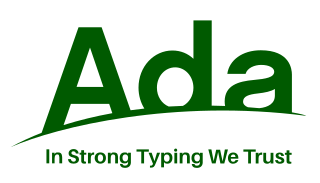
Ada is a structured, statically typed, imperative, and object-oriented high-level programming language, inspired by Pascal and other languages. It has built-in language support for design by contract (DbC), extremely strong typing, explicit concurrency, tasks, synchronous message passing, protected objects, and non-determinism. Ada improves code safety and maintainability by using the compiler to find errors in favor of runtime errors. Ada is an international technical standard, jointly defined by the International Organization for Standardization (ISO), and the International Electrotechnical Commission (IEC). As of May 2023, the standard, called Ada 2022 informally, is ISO/IEC 8652:2023.
In object-oriented programming, a class is an extensible program-code-template for creating objects, providing initial values for state and implementations of behavior.
Eiffel is an object-oriented programming language designed by Bertrand Meyer and Eiffel Software. Meyer conceived the language in 1985 with the goal of increasing the reliability of commercial software development; the first version becoming available in 1986. In 2005, Eiffel became an ISO-standardized language.

The Netwide Assembler (NASM) is an assembler and disassembler for the Intel x86 architecture. It can be used to write 16-bit, 32-bit (IA-32) and 64-bit (x86-64) programs. It is considered one of the most popular assemblers for Linux and x86 chips.
In computer programming, a type system is a logical system comprising a set of rules that assigns a property called a type to every term. Usually the terms are various language constructs of a computer program, such as variables, expressions, functions, or modules. A type system dictates the operations that can be performed on a term. For variables, the type system determines the allowed values of that term. Type systems formalize and enforce the otherwise implicit categories the programmer uses for algebraic data types, data structures, or other components.
In programming language theory, subtyping is a form of type polymorphism. A subtype is a datatype that is related to another datatype by some notion of substitutability, meaning that program elements, written to operate on elements of the supertype, can also operate on elements of the subtype.

The Liskov substitution principle (LSP) is a particular definition of a subtyping relation, called strong behavioral subtyping, that was initially introduced by Barbara Liskov in a 1987 conference keynote address titled Data abstraction and hierarchy. It is based on the concept of "substitutability" – a principle in object-oriented programming stating that an object may be replaced by a sub-object without breaking the program. It is a semantic rather than merely syntactic relation, because it intends to guarantee semantic interoperability of types in a hierarchy, object types in particular. Barbara Liskov and Jeannette Wing described the principle succinctly in a 1994 paper as follows:
Subtype Requirement: Let be a property provable about objects of type T. Then should be true for objects of type S where S is a subtype of T.
In computer science, reflective programming or reflection is the ability of a process to examine, introspect, and modify its own structure and behavior.
The fragile base class problem is a fundamental architectural problem of object-oriented programming systems where base classes (superclasses) are considered "fragile" because seemingly safe modifications to a base class, when inherited by the derived classes, may cause the derived classes to malfunction. The programmer cannot determine whether a base class change is safe simply by examining in isolation the methods of the base class.
A Perl module is a discrete component of software for the Perl programming language. Technically, it is a particular set of conventions for using Perl's package mechanism that has become universally adopted.
Object Pascal is an extension to the programming language Pascal that provides object-oriented programming (OOP) features such as classes and methods.
High Level Assembly (HLA) is a language developed by Randall Hyde that allows the use of higher-level language constructs to aid both beginners and advanced assembly developers. It fully supports advanced data types and object-oriented programming. It uses a syntax loosely based on several high-level programming languages (HLLs), such as Pascal, Ada, Modula-2, and C++, to allow the creation of readable assembly language programs, and to allow HLL programmers to learn HLA as fast as possible.
Aldor is a programming language. It is the successor of A# as the extension language of the Axiom computer algebra system.
E is an object-oriented programming language for secure distributed computing, created by Mark S. Miller, Dan Bornstein, Douglas Crockford, Chip Morningstar and others at Electric Communities in 1997. E is mainly descended from the concurrent language Joule and from Original-E, a set of extensions to Java for secure distributed programming. E combines message-based computation with Java-like syntax. A concurrency model based on event loops and promises ensures that deadlock can never occur.
In mathematics and in computer programming, a variadic function is a function of indefinite arity, i.e., one which accepts a variable number of arguments. Support for variadic functions differs widely among programming languages.
this, self, and Me are keywords used in some computer programming languages to refer to the object, class, or other entity which the currently running code is a part of. The entity referred to thus depends on the execution context. Different programming languages use these keywords in slightly different ways. In languages where a keyword like "this" is mandatory, the keyword is the only way to access data and methods stored in the current object. Where optional, these keywords can disambiguate variables and functions with the same name.

Vala is an object-oriented programming language with a self-hosting compiler that generates C code and uses the GObject system.

Object-oriented programming (OOP) is a programming paradigm based on the concept of objects, which can contain data and code: data in the form of fields, and code in the form of procedures. In OOP, computer programs are designed by making them out of objects that interact with one another.
Typestate analysis, sometimes called protocol analysis, is a form of program analysis employed in programming languages. It is most commonly applied to object-oriented languages. Typestates define valid sequences of operations that can be performed upon an instance of a given type. Typestates, as the name suggests, associate state information with variables of that type. This state information is used to determine at compile-time which operations are valid to be invoked upon an instance of the type. Operations performed on an object that would usually only be executed at run-time are performed upon the type state information which is modified to be compatible with the new state of the object.

Nim is a general-purpose, multi-paradigm, statically typed, compiled high-level systems programming language, designed and developed by a team around Andreas Rumpf. Nim is designed to be "efficient, expressive, and elegant", supporting metaprogramming, functional, message passing, procedural, and object-oriented programming styles by providing several features such as compile time code generation, algebraic data types, a foreign function interface (FFI) with C, C++, Objective-C, and JavaScript, and supporting compiling to those same languages as intermediate representations.





